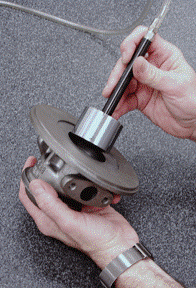George Schuetz, Mahr Inc.
Can dirt impact gaging measurements? This article looks at what things can be done to keep your air gage acting properly and without mistakes. You can see other articles about gaging at https://www.mahr.de/en-us/Services/Production-metrology/Know-how/Gaging-Tips/.
Accurate air gaging requires proper maintenance of the tooling and vigilance over the air supply. Although the factory air supply may not be under the gage user’s control—compressors and air lines may be shared by dozens of other users—the gage user must ensure that the air reaching his gage is clean, dry, and fairly stable in pressure. Tooling, on the other hand, is directly under the gage user’s control, and he is responsible for its maintenance.
Even in invisible quantities, dirt can skew a measurement, both on the contacting surfaces of the gage, and on the workpiece or master, even in reasonably clean environments. Now picture the common abode of a gage in your shop: it is probably living on the oil-and-chip-filled bench of a lathe or screw machine, or sitting on a shelf by the same machine being sprayed by who knows what.
Proper tool maintenance simply means keeping components clean and dry inside and out. Contaminants such as chips, dirt, coolant, and cutting fluid may be picked up from workpieces, while water and oil are likely to come from the air source itself. Although the air flow tends to clear out most air passages on its own, some contamination may occur in the master jet or measuring jets. Even accumulations of only a few millionths of an inch can throw off a measurement. The gage must be inspected and cleaned when necessary. Repeated mastering that produces varying readings is a good indication of dirty jets.
Shop air is difficult to keep clean and dry. Air dryers are not entirely adequate. The very act of compressing air produces moisture, and a compressor’s need for lubrication inevitably generates some oil mist in the line. Our goal, however, is simply to prevent mist from entering the gage and fouling the jets. To do this, we must employ proper air-line design to intercept it before it enters the meter. Air main lines should be pitched down from the source, with a proper trap installed on the end. Take air from the top rather than the bottom of the mains, so that moisture doesn’t drain into the feed. Gages must always have a filter in place when operating, and this should be changed when it becomes saturated.
Dirt is dirt, but it’s sometimes a little confusing to identify where the dirt is, and which source is the biggest contributor to measurement errors. Here is a case most detectives would love to take on: A typical air plug was not performing as it should. While still relatively new, there was a bit of a bias in its readings, or sometimes it would not repeat as well as typical air plugs. So after some discussion with the customer, the whole system came back for a warranty repair.
When it arrived I was immediately called to the repair department by the supervisor. “Obvious,” he said. “Look at this gage: the hoses have turned yellow from the oil and dirt in the air supply. The reason for the funky readings has to be a contaminated meter: oil has ruined the display.”
A call to the customer from the repair group about this problem did not go well. He said his air was perfect: they had proper filtering, and oil and water separators. Sure the gaging was used in a tough shop environment, but the air was clean.
So, it was back to the gaging for a closer look. With the clear tubing all yellowed, it was obvious that it had seen some type of reaction to the environment. So we pulled the internal air filter out of the air gage display and there was a sudden silence from the repair manager. The filter was as white and pure as driven snow. So the contamination affecting the gage performance was not from the inside but rather from the shop environment itself.
With the air display and hoses no longer suspect, that only left the tooling. A close look under a magnifying glass at the air jets clarified the issue. While in most cases air tends to clean itself and the part, air cannot always take care of every situation. In this case one of the escape grooves for excess air had become clogged with part sludge, causing excessive air pressure to be seen by the gage. A quick flick of the blockage resolved the problem.
So the moral is look for dirt coming and going: you never know which one is going to clog things up for you today.

